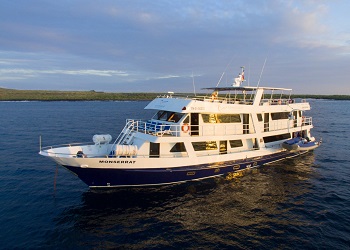Coral I&II Itinerary D - 5 Days
ITINERARY D - 5 DAYS
WEDNESDAY
AM: San Cristobal Arrival and Transfer to the Boat
PM: San Cristobal: Interpretation Center / Frigatebird Hill (HK)
THURSDAY
AM: San Cristobal: Witch Hill / Kicker Rock (HK/SN/KY/PR)
PM: San Cristobal: Pitt Point (HK/SN/KY)
FRIDAY
AM: Espanola: Suarez Point (HK)
PM: Espanola: Gardner Bay / Osborn Islet (HK/SN/KY)
SATURDAY
AM: Floreana: Cormorant Point / Devil's Crown (PR/SN)
PM: Floreana: Post Office Bay (HK/SN)
SUNDAY
AM: Santa Cruz: highlands Tortoise Research (HK)
Baltra: Transfer to the Airport
HK: HIKE / SN: SNORKEL / PR: PANGA RIDE / KY: KAYAK /
PB: PADDLE BOARD
DAY 1: WEDNESDAY
AM: SAN CRISTOBAL ARRIVAL AND TRANSFER TO THE BOAT
Departure from either Quito or Guayaquil to Baltra Island is a 2 ½ hour flight. Uponarrival in the Galapagos, passengers are greeted at the airport by our knowledgeable guides who will accompany them on a short ten-minute bus ride to the pier where they will board the Coral I or Coral II.
PM: INTERPRETATION CENTER / FRIGATEBIRD HILL
The interpretation center is full of interesting information and offers a perfect overview of the formation of the Galapagos. After a hike to Cerro Tijeretas we will have a great view of the two species of frigates, with the advantage of a beautiful view of the bay.
DAY 2: THURSDAY
AM: SAN CRISTOBAL: WITCH HILL / KICKER ROCK
Kicker Rock : This ancient and eroded volcanic tuff lava named Leon Dormido or Kicker Rock, is formed from two rocks approximately 148 m, named for its resemblance to a sleeping lion. Cerro Brujo: From our dinghy ride, as we head to shore, we are first humbled by the immensity of the stunning cliffs of the Sorcerer's Hill. You can enjoy simply sharing the beach with sea lions, snorkelling from shore, or taking a walk to a hidden lagoon Duration1 hour 15 min hike1 hour beach snorkeling.
PM: SAN CRISTOBAL: PITT POINT
This is the only place on the islands where we will enjoy the chance to see all three of the booby species in the same place. The red-foots will be perched on the Cordia lutea and small trees, the Nazca ́s on the ground near the cliff edge while the blue-foots will be a little further inland. Frigatebirds will be all around and the views are breathtaking.
DAY 3: FRIDAY
AM: ESPANOLA: SUAREZ POINT
Punta Suarez is a naturalist ́s paradise. The oldes extant island in the archipelago is our only opportunity to commune with the endemic wave albatross during their breeding season between April and December. With luck, we can watch their complex courtship display.
PM: ESPANOLA: GARDNER BAY
One of the most stunning beaches in all of the Galapagos. The long, white, sandy beach, lapped by turquoise waters, home to a colony of Galapagos sea lions. Hood mockingbirds, endemic to this particular island. We can also snorkel here from the beach, in the shallows of the bay
DAY 4: SATURDAY
AM: FLOREANA: CORMORANT POINT
Our walk takes us to a large, shallow lagoon, often inhabited by a variable number of shockingly pink greater flamingos. We arrive at a powdery white beach, a nesting area for green turtles.
PM: FLOREANA: POST OFFICE BAY
The famous Post Office Barrel. Claimed to have been first set up in 1793 by Captain James Colnett. The system involved whalers and fur sealers would leave addressed letters in the barrel to be picked up by homeward-bound colleagues. Actually visitors often take letters and hand-deliver them to their home countries
DAY 5: SUNDAY
AM: SANTA CRUZ: HIGHLANDS TORTOISE RESEARCH
Dry landing. In the Galapagos mountains, admire diverse bird species like finches, flycatchers, crakes, warblers, and egrets (often perched on tortoises' shells). The journey to the reserve showcases the island's contrasting ecosystems, from coastal areas to dense humid forests. Look out for Galapagos Giant tortoises wandering through pastures. This spot is a haven for birdwatchers, as it hosts a wide range of land birds that reside or migrate here.
After the visit, passengers will be transferred to the airport for their return flight to Guayaquil or Quito.







